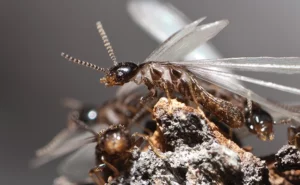
Termites rock on
Frank Lloyd Wright built a home in Westchester County, N.Y., for a wealthy family who once lived in California. The wife was petrified of earthquakes and had her husband build this special house.
Eastern subterranean termites (Reticulitermes flavipes) were constructing a few mud tubes up through cracks in the basement floor. No other signs were noted inside or outside. This occurred in the days before termite baiting technology; soil treatments were the standard method of control.
The house was built on a huge rock that jutted out of the ground along the entire back of the structure. Whether you attempted to drill inside or outside the house, you drilled directly into a huge rock. A foaming application did not make much of a difference.
In the basement, the couple stored expensive paintings resting against and directly on the basement floor.
Solution: We moved the paintings onto metal racks where they could be inspected at will. The mud tubes were broken and we placed a roll of toilet paper flat on the floor over the cracks so we could detect if new termite activity was going to occur. We put the house under an early-spring, mid-summer and late-fall inspection schedule.
For the first few years, inspections recorded some termite activity, but the infestation never had a chance to become established. Decades later, we installed termite baits. The termites readily ate the bait, and the colony was eliminated.
Conclusion: The more exotic the design of a structure, the more challenging it is to control subterranean termites. You cannot “inject subsoil” termiticide under a slab if there is no soil to accept it.
Ducting termites
Eastern subterranean termites were eating cardboard heating ducts under and in a slab. The room contained a large, heated swimming pool. Again, this occurred in the days before termite baits.
Solution: We disconnected the heating ducts and treated them with a liquid foam termiticide. We then had the ducts filled with concrete. New heating ducts were established above-ground to heat the room.
Conclusion: Who would think of putting cardboard heating ducts into a slab? You cannot always please the customer with an easy solution.
Hungry, hungry coneheads
Conehead termites (Nasutitermes corniger) were attacking cardboard boxes meant to store plastic covers for pharmaceutical containers.
Solution: Nasutitermes is a common genus of arboreal termites that build their nests in trees. In this case, a poorly lighted area of a warehouse was discovered with mud tubes on some of the stacked individual boxes.
Tracing back in the direction of the tunnels revealed that it led directly to an arboreal termite nest about 20 feet from the warehouse.
We asked the customer to destroy any boxes with mud or live termites. We used commercial bait on the nest, and the infestation was eliminated within two months.
Conclusion: You can get calls for termite control in buildings without any structural wood. They may be eating magazines, cardboard boxes or even toilet paper. Termites do not follow what it says about them in pest control books. In fact, they may eat the books.
Leave A Comment